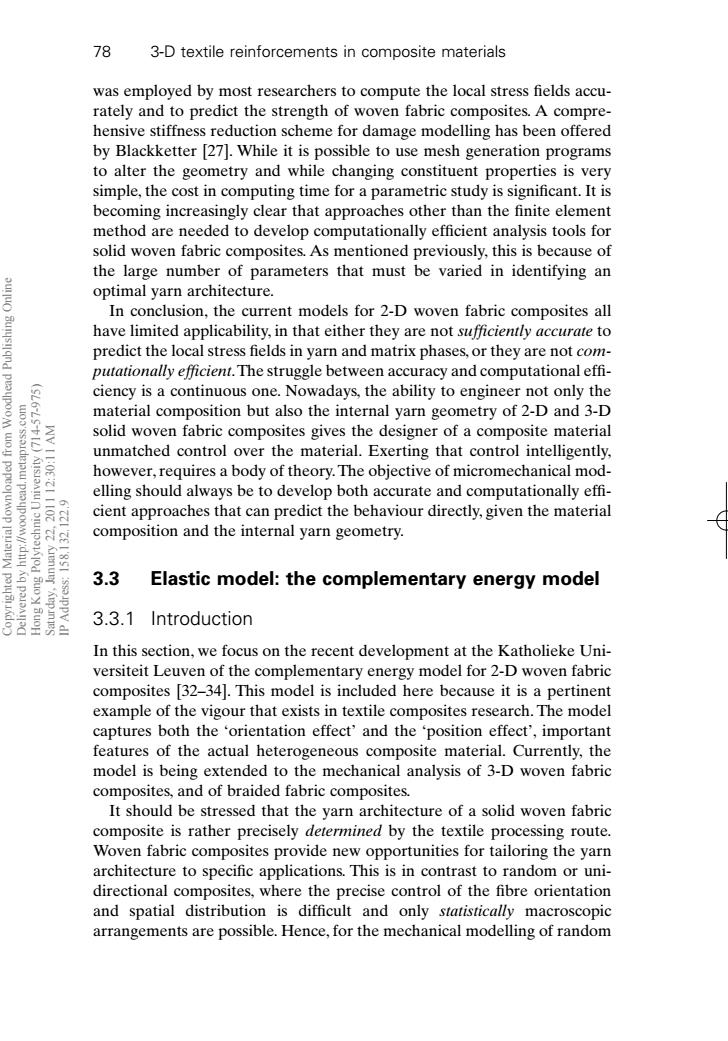正在加载图片...

78 3-D textile reinforcements in composite materials was employed by most researchers to compute the local stress fields accu- rately and to predict the strength of woven fabric composites.A compre- hensive stiffness reduction scheme for damage modelling has been offered by Blackketter [27].While it is possible to use mesh generation programs to alter the geometry and while changing constituent properties is very simple,the cost in computing time for a parametric study is significant.It is becoming increasingly clear that approaches other than the finite element method are needed to develop computationally efficient analysis tools for solid woven fabric composites.As mentioned previously,this is because of the large number of parameters that must be varied in identifying an optimal yarn architecture. In conclusion,the current models for 2-D woven fabric composites all have limited applicability,in that either they are not sufficiently accurate to predict the local stress fields in yarn and matrix phases,or they are not com- putationally efficient.The struggle between accuracy and computational effi- ciency is a continuous one.Nowadays,the ability to engineer not only the material composition but also the internal yarn geometry of 2-D and 3-D solid woven fabric composites gives the designer of a composite material 1:00 unmatched control over the material.Exerting that control intelligently, however,requires a body of theory.The objective of micromechanical mod- elling should always be to develop both accurate and computationally effi- cient approaches that can predict the behaviour directly,given the material pua composition and the internal yarn geometry. 3.3 Elastic model:the complementary energy model 8 3.3.1 Introduction In this section,we focus on the recent development at the Katholieke Uni- versiteit Leuven of the complementary energy model for 2-D woven fabric composites [32-34].This model is included here because it is a pertinent example of the vigour that exists in textile composites research.The model captures both the 'orientation effect'and the 'position effect',important features of the actual heterogeneous composite material.Currently,the model is being extended to the mechanical analysis of 3-D woven fabric composites,and of braided fabric composites. It should be stressed that the yarn architecture of a solid woven fabric composite is rather precisely determined by the textile processing route. Woven fabric composites provide new opportunities for tailoring the yarn architecture to specific applications.This is in contrast to random or uni- directional composites,where the precise control of the fibre orientation and spatial distribution is difficult and only statistically macroscopic arrangements are possible.Hence,for the mechanical modelling of randomwas employed by most researchers to compute the local stress fields accurately and to predict the strength of woven fabric composites. A comprehensive stiffness reduction scheme for damage modelling has been offered by Blackketter [27]. While it is possible to use mesh generation programs to alter the geometry and while changing constituent properties is very simple, the cost in computing time for a parametric study is significant. It is becoming increasingly clear that approaches other than the finite element method are needed to develop computationally efficient analysis tools for solid woven fabric composites. As mentioned previously, this is because of the large number of parameters that must be varied in identifying an optimal yarn architecture. In conclusion, the current models for 2-D woven fabric composites all have limited applicability, in that either they are not sufficiently accurate to predict the local stress fields in yarn and matrix phases, or they are not computationally efficient.The struggle between accuracy and computational effi- ciency is a continuous one. Nowadays, the ability to engineer not only the material composition but also the internal yarn geometry of 2-D and 3-D solid woven fabric composites gives the designer of a composite material unmatched control over the material. Exerting that control intelligently, however, requires a body of theory.The objective of micromechanical modelling should always be to develop both accurate and computationally effi- cient approaches that can predict the behaviour directly, given the material composition and the internal yarn geometry. 3.3 Elastic model: the complementary energy model 3.3.1 Introduction In this section, we focus on the recent development at the Katholieke Universiteit Leuven of the complementary energy model for 2-D woven fabric composites [32–34]. This model is included here because it is a pertinent example of the vigour that exists in textile composites research. The model captures both the ‘orientation effect’ and the ‘position effect’, important features of the actual heterogeneous composite material. Currently, the model is being extended to the mechanical analysis of 3-D woven fabric composites, and of braided fabric composites. It should be stressed that the yarn architecture of a solid woven fabric composite is rather precisely determined by the textile processing route. Woven fabric composites provide new opportunities for tailoring the yarn architecture to specific applications. This is in contrast to random or unidirectional composites, where the precise control of the fibre orientation and spatial distribution is difficult and only statistically macroscopic arrangements are possible. Hence, for the mechanical modelling of random 78 3-D textile reinforcements in composite materials RIC3 7/10/99 7:37 PM Page 78 Copyrighted Material downloaded from Woodhead Publishing Online Delivered by http://woodhead.metapress.com Hong Kong Polytechnic University (714-57-975) Saturday, January 22, 2011 12:30:11 AM IP Address: 158.132.122.9